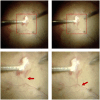Case reports: Intraoperative migratory retinal venous thrombus in proliferative diabetic retinopathy
- PMID: 39314228
- PMCID: PMC11417017
- DOI: 10.3389/fmed.2024.1372831
Case reports: Intraoperative migratory retinal venous thrombus in proliferative diabetic retinopathy
Abstract
Purpose: This study aimed to study the characteristics, possible causes, and clinical implications of intraoperative migratory retinal venous thrombus in proliferative diabetic retinopathy (PDR).
Cases: Two middle-aged Chinese patients with diabetes mellitus presented with blurred vision and were diagnosed with PDR and tractional retinal detachment (TRD). An interesting phenomenon was observed during pars plana vitrectomy in both patients. Movement of tiny white thrombi and interruption of blood flow were observed in a branch of the central retinal vein when the vein was pulled at the time of fibrovascular membrane delamination and disappeared with the elimination of retinal traction after finishing the process of delamination. Laboratory studies revealed abnormal erythrocyte sedimentation rate, fibrinogen, D-dimer, international normalized ratio, and IgA anti-β2-glycoprotein I in one patient and elevated fibrinogen and IgA anticardiolipin in the other. Follow-up examinations at 1 week, 1, 3, and 6 months postoperatively showed good prognosis. Fluorescein fundus angiography at 1 month postoperatively showed neither embolus sign nor prolonged venous filling time in both patients.
Discussion: Local blood stasis of the retinal vein persistently dragged by the fibrovascular membrane may result in thrombogenesis, and traction of the retina during the delamination process may lead to the movement of thrombi. On the other hand, endothelial injury and disordered local blood stasis during delamination may also activate the biological coagulation process and instant thrombus formation. As well, antiphospholipid antibodies may also be a risk factor of ocular thrombogenesis.
Conclusion: This study provides the first videos recording migratory thrombus in terminal vessels, which indicates that fibrovascular membrane in PDR can lead to thrombogenesis due to dragging and hemostasis of the involved retinal vein. PDR patients with fibrovascular membranes may benefit from early relief of vascular traction through fibrovascular membrane delamination.
Keywords: fibrovascular membrane delamination; migratory retinal venous thrombus; proliferative diabetic retinopathy; tractional retinal detachment; vitrectomy.
Copyright © 2024 Lyu, Liu, Fang and Wang.
Conflict of interest statement
The authors declare that the research was conducted in the absence of any commercial or financial relationships that could be construed as a potential conflict of interest.
Figures







References
Publication types
LinkOut - more resources
Full Text Sources
Research Materials
Miscellaneous

